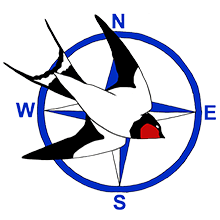The Birds of Wales/Adar Cymru
It is not by chance that the front cover of The Birds of Wales, painted by Philip Snow, features Manx Shearwaters flying through the breakers off Skokholm. Wales holds half of the World’s Manxie population, and Skokholm was, of course, the first bird observatory in Britain & Ireland.
It is more than 25 years since the first and only avifauna was published for all of Wales and much has changed. Knowledge of the status of many species has increased thanks to improved monitoring and a greater number of birdwatchers, and we have a better understanding of how humans have affected bird populations, particularly the twin challenges of land-use and climate change. The Birds of Wales, published in July by the Welsh Ornithological Society and Liverpool University Press, synthesises new information in the context of each species’ history in Wales. The book tells the stories of all 451 species recorded in the wild, common and rare, and anticipates what may occur in the coming decades.
Records from the two Welsh bird observatories, on Bardsey and Skokholm, have been invaluable in writing the book. Many species were recorded for the first time in Wales (and in some cases Britain) at one of the observatories. Skokholm has added 27 species to the Welsh List, including the 300th, Olive-backed Pipit in April 1948, while Bardsey has added 37, including the 400th species, Lanceolated Warbler in 1990.
The digitisation of historic data by both observatories on BirdTrack enabled their huge datasets to be used to chart the patterns of timing by visiting common migrants, and the efforts of generations of ringers on the two islands have revealed much about bird movements. Top of the list is a Manx Shearwater ringed as an adult on Bardsey in 1957 that was caught again there in May 2008, almost 51 years later. It is the longest-lived ringed bird in Europe.
The Birds of Wales will have an essential place on the bookshelf of everyone with an interest in birds in Wales, and should be on the desk or in the rucksack of everyone who influences what happens to the nation’s land and seas. It is a once-in-a-generation publication.
It can be ordered at the pre-publication price of £25, plus p&p until 30 June. Use the code WALES50 online at Liverpool University Press or phone 07766 472078. After publication, on 1 July, it will cost £45. You can download an order form by clicking on the image below.

